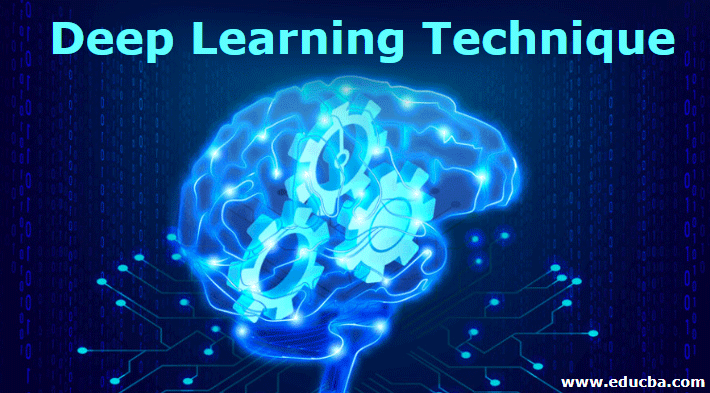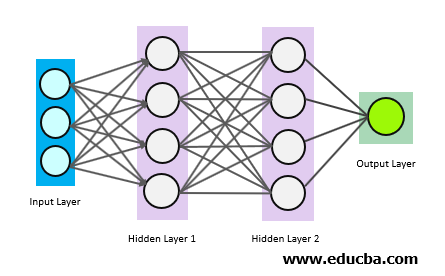Updated May 8, 2023

Introduction to Deep Learning Technique
Deep Learning Techniques are the techniques used for mimicking the functionality of human brain, by creating models that are used in classifications from text, images and sounds. These models are made up of several layers of hidden layer also know as Neural network which can extract features from the data, each layer of these neural networks starting from the left-most layer to the rightmost layer extract a low-level feature like edge and subsequently make predictions accurately.
Working of Deep Learning
Deep Learning methods use Neural Networks. So, they are often referred to as Deep Neural Networks. Deep or hidden Neural Networks have multiple hidden layers of deep networks. Deep Learning trains the AI to predict output with the help of certain inputs or hidden network layers. These networks are trained by large labeled datasets and learn features from the data itself. Both Supervised and Unsupervised Learning works in training the data and generating features.
The above circles are neurons that are interconnected. There are 3 types of neurons:
- Input layer
- Hidden layer(s)
- Output layer
The input layer gets the input data and passes the input to the first hidden layer. The mathematical calculations are performed on the input data. Finally, the output layer gives the findings.
CNN or Conventional Neural Networks, one of the most popular Neural Networks convolves features learned from the input data and uses 2D convolutional layers to make it suitable for processing 2D data like images. So, CNN reduces the use of manual extraction of features in this case. It directly extracts the required features from images for classification. Because of this automation feature, CNN is a mostly accurate and reliable algorithm in Machine Learning. Every CNN learns features of images from the hidden layer and these hidden layers increase the complexity of learned images.
The important part is to train the AI or Neural Networks. To do so, we give input from the dataset and finally make a comparison of the outputs with the help of the output of the dataset. If the AI is untrained, the output may be wrong.
To find out how wrong is the AI’s output from the real output, we need a function for calculation. The function is called cost function. If the cost function is zero, then both AI’s output and real output are the same. To reduce the value of cost function, we change the weights between the neurons. For a convenient approach, a technique called Gradient Descent can be used. GD reduces the weight of neurons to a minimum after every iteration. This process is done automatically.
Deep Learning Technique
Deep Learning algorithms run through several layers of the hidden layer(s) or Neural Networks. So, they learn deeply about the images for accurate prediction. Every layer learns and detects low-level features like edges and subsequently, the new layer merges with the features of the earlier layer for better representation. For example, a middle layer might detect any edge of the object while the hidden layer will detect the full object or image.
This technique is efficient with large and complex data. If the data is small or incomplete, DL becomes incapable to work with new data.
There are some Deep Learning Networks as follows:
- Unsupervised Pre-trained Network: It is a basic model with 3 layers: input, hidden and output layer. The network is trained to reconstruct the input and then hidden layers learn from the inputs to gather information and finally, features are extracted from the image.
- Conventional Neural Network: As standard Neural Network, it has a convolution inside for edge detection and accurate recognition of objects.
- Recurrent Neural Network: In this technique, the output from the previous stage is used as input for the next or current stage. RNN stores the information in context nodes to learn the input data and produce the output. For example, to complete a sentence we need words. i.e to predict the next word, previous words are required which needs to be remembered. RNN basically solves this type of problem.
- Recursive Neural Networks: It is a hierarchical model where the input is a tree-like structure. This kind of network is created by applying the same set of weights over the assembly of inputs.
Deep Learning has got a variety of applications in financial fields, computer vision, audio and speech recognition, medical image analysis, drug design techniques, etc.
How to Create Deep Learning Models?
Deep Learning algorithms are made by connecting layers between them. The first step above is the input layer followed by the hidden layer(s) and the output layer. Each layer is composed of interlinked neurons. The network consumes a large amount of input data to operate them through multiple layers.
To create a Deep Learning model, the following steps are needed:
- Understanding the problem
- Identify data
- Select the algorithm
- Train the model
- Test the model
Learning Occurs in Two Phases
- Apply a non-linear transformation of the input data and create a statistical model as output.
- The model is improved with a derivative method.
These two phases of operations are known as iteration. Neural Networks repeat the two steps until the desired output and accuracy is generated.
1. Training of networks: To train a network of data, we collect a large number of data and design a model that will learn the features. But the process is slower in case of a very large number of data.
2. Transfer Learning: Transfer Learning basically tweaks a pre-trained model and a new task is performed afterwards. In this process, the computation time becomes lesser.
3. Feature Extraction: After all the layers are trained about the features of the object, features are extracted from it and output is predicted with accuracy.
Conclusion
Deep Learning is a subset of ML and ML is a subset of AI. All three technologies and models have a huge impact on real life. Business entities, Commercial giants are implementing Deep Learning models for superior and comparable results for automation which is inspired by human brains.
Recommended Articles
This is a guide to Deep Learning Technique. Here we discuss how to Create Deep Learning Models along with the two phases of operation. You may also look at the following articles to learn more –

